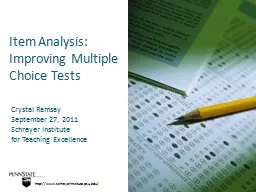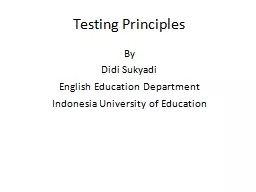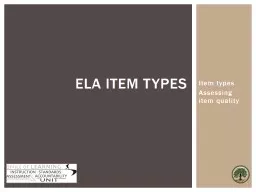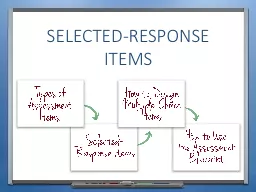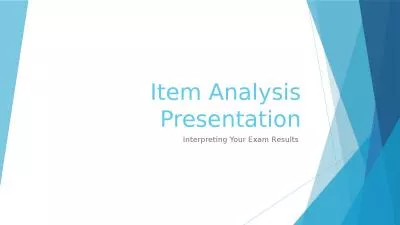PPT-Item Analysis: Improving Multiple Choice Tests
Author : marina-yarberry | Published Date : 2020-01-26
Item Analysis Improving Multiple Choice Tests httpwwwschreyerinstitutepsuedu Crystal Ramsay September 27 2011 Schreyer Institute for T eaching Excellence This workshop
Presentation Embed Code
Download Presentation
Download Presentation The PPT/PDF document "Item Analysis: Improving Multiple Choic..." is the property of its rightful owner. Permission is granted to download and print the materials on this website for personal, non-commercial use only, and to display it on your personal computer provided you do not modify the materials and that you retain all copyright notices contained in the materials. By downloading content from our website, you accept the terms of this agreement.
Item Analysis: Improving Multiple Choice Tests: Transcript
Item Analysis Improving Multiple Choice Tests httpwwwschreyerinstitutepsuedu Crystal Ramsay September 27 2011 Schreyer Institute for T eaching Excellence This workshop is designed to help you do three. Original version. : . You should gel your hands before you interact with each patient?. True. False. Scenario version. :. David and Tanya carpool and park in the garage each day. As they leave the car, they get on the elevator and then proceed across the bridge to the Medical Building. They press the elevator button, board the elevator and go up to the 4th floor. As they get off the elevator, they use their card to open the staff entrance door and proceed to the staff room where they hang up their coats and put their bags away. They then make their way over to the department nursing station, gel their hands and pick up their first patient chart for the day.. Characters. She finally forgives . Tris. for killing her boyfriend. Christina. Characters. Amanda Ritter’s daughter. Tris. Characters. Leader of the Dauntless traitors who is stabbed by . Tris. Eric. Writing Better Multiple Choice Questions. . . . Presented to AMATYC. February 2, 2015. by. Patricia L. Gregg, PhD (Patti). 1. Inventory that is carried to provide a cushion against uncertainty of the demand is called. A) Seasonal inventory. B) Safety Stock. C) Cycle stock. D) Pipeline inventory. E) Speculative inventory. Brandon Chang, Thomas Chang. Monopolistic Competition . Characteristics. Market structure where there are large number of sellers.. Sells slightly differentiated products.. Has some price setting power. By. Didi Sukyadi. English Education Department. Indonesia University of Education. Practicality. Is not excessively expensive. Stays within appropriate time constraints. Is relatively easy to administer. Demystifying the “K-Type”. Goal of Presentation. To provide students with strategies on how to prepare for exams and how to . strategically. answer multiple choice questions.. . 2. About Multiple Choice Questions. Website. Website: . https://apstudent.collegeboard.org/apcourse/ap-calculus-ab. . Practice Tests. Released FRQ’s and Multiple Choice Tests. Practice . Practice Books, getafive.com . AP Central. AP Review. ELA Item TYPES. 4 building blocks. Learning Progression. Item Design. Outcomes/Scoring. Assessment Quality. Classification of item types: . Objective. Performance based. Item types (SBAC, 2012, pp. 27 – 32):. Students . select a response. Students . c. onstruct . a . response. Students create products or perform . tasks . to show their mastery of a particular skill. INTRODUCTION & OBJECTIVES. Define what a . Breast collar. Breast collars are designed to keep a saddle from sliding back or. s. ide to side when on a horse. The breast collar, or breastplate, is. a. ttached around the horse’s chest. This item is typically made out. Interpreting Your Exam Results . Item Analysis Presentation: Overview. Why is understanding your exam’s item analysis important.. Psychometrics used to understand your exam results. ExamSoft:. Where to find your exam performance results.. Jodi Knapp: The Multiple Sclerosis Solution PDF, The Multiple Sclerosis Solution Free Download, The Multiple Sclerosis Solution eBook, The Multiple Sclerosis Solution Reviews, The Multiple Sclerosis Solution Exercises, The Multiple Sclerosis Solution Reddit, Buy The Multiple Sclerosis Solution Discount, The Multiple Sclerosis Solution Remedies, The Multiple Sclerosis Solution Blue Heron Health News. Yuanyuan . Gu, PhD. Senior Research Fellow. CENTRE FOR THE HEALTH ECONOMY. Co . authors:. Henry Cutler, PhD. Director. Emma Olin. Research Fellow. AHES Conference 2017. Introduction. Background and study objectives.
Download Document
Here is the link to download the presentation.
"Item Analysis: Improving Multiple Choice Tests"The content belongs to its owner. You may download and print it for personal use, without modification, and keep all copyright notices. By downloading, you agree to these terms.
Related Documents

